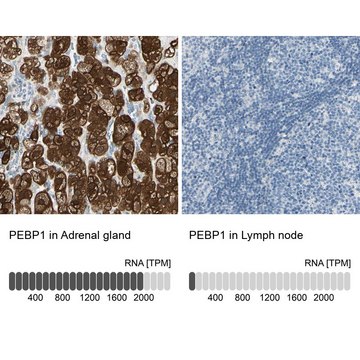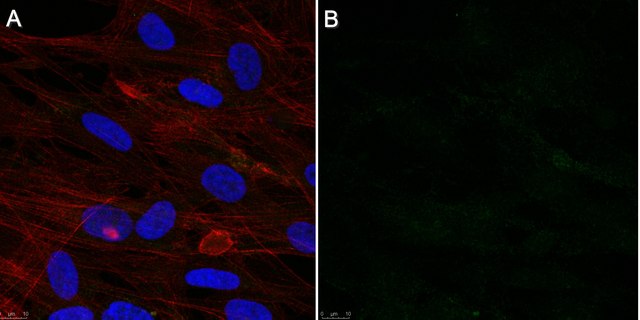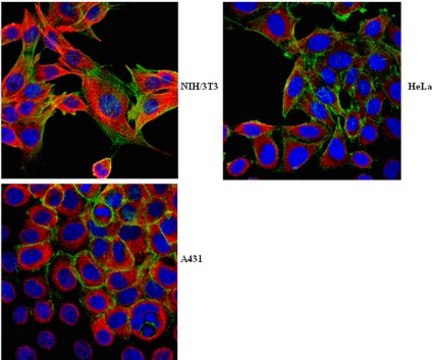All Photos(2)
Synonym(s):
Proliferation-associated protein 2G4, Cell cycle protein p38-2G4 homolog, hG4-1, ErbB3-binding protein 1, Cell cycle protein p38-2G4 homolog, ErbB-3 binding protein 1, ErbB3-binding protein Ebp1
UNSPSC Code:
12352203
eCl@ss:
32160702
NACRES:
NA.41
Recommended Products
biological source
rabbit
Quality Level
antibody form
serum
antibody product type
primary antibodies
clone
polyclonal
species reactivity
mouse, rat, human
technique(s)
immunocytochemistry: suitable
western blot: suitable
isotype
IgG
NCBI accession no.
UniProt accession no.
shipped in
wet ice
target post-translational modification
unmodified
Gene Information
human ... PA2G4(5036)
General description
Ebp1 is an RNA-binding protein involved in growth regulation. In cancer cells, this protein and has been implicated in growth inhibition and differentiation. Ebp1 is known to bind ribosomal and double-stranded RNA. It is a found in pre-ribosomal ribonucleoprotein complexes and is believed to play a role in ribosome assembly and rRNA processing. This protein is also a component of cytoplasmic bcl-2 messenger ribonucleoprotein. Through interactions with histion deacetylases, this protein can act transcriptional co-repressor of androgen receptor-regulated genes and other cell cycle regulatory genes. Ebp1 also interacts with the cytoplasmic domain of the ErbB3 receptor, potentially transducing regulatory growth signals.
Specificity
Recognizes Ebp-1.
Immunogen
Epitope: N-terminus
Linear Peptide corresponding to the N-terminus of Ebp1.
Application
Anti-Ebp1 N-terminal Antibody is a Rabbit Polyclonal Antibody for detection of Ebp1 also known as Proliferation-associated protein 2G4 & has been validated in WB, ICC.
Immunocytochemistry:
A 1:500 dilution from a representative lot detected Ebp1 in NIH/3T3, A431, and HeLa cells.
A 1:500 dilution from a representative lot detected Ebp1 in NIH/3T3, A431, and HeLa cells.
Research Category
Epigenetics & Nuclear Function
Epigenetics & Nuclear Function
Epigenetics & Nuclear Function
Epigenetics & Nuclear Function
Research Sub Category
RNA Metabolism & Binding Proteins
Chromatin Biology
RNA Metabolism & Binding Proteins
Chromatin Biology
Quality
Evaluated by Western Blotting in A431 cell lysate.
Target description
48 kDa Observed
Linkage
Replaces: 07-397
Physical form
Rabbit Polyclonal Serum with 0.05% sodium azide
Unpurified
Storage and Stability
Stable for 1 year at -20°C from date of receipt.
Handling Recommendations: Upon receipt and prior to removing the cap, centrifuge the vial and gently mix the solution. Aliquot into microcentrifuge tubes and store at -20°C. Avoid repeated freeze/thaw cycles, which may damage IgG and affect product performance.
Handling Recommendations: Upon receipt and prior to removing the cap, centrifuge the vial and gently mix the solution. Aliquot into microcentrifuge tubes and store at -20°C. Avoid repeated freeze/thaw cycles, which may damage IgG and affect product performance.
Analysis Note
Control
A431 Cell Lysate.
A431 Cell Lysate.
Disclaimer
Unless otherwise stated in our catalog or other company documentation accompanying the product(s), our products are intended for research use only and are not to be used for any other purpose, which includes but is not limited to, unauthorized commercial uses, in vitro diagnostic uses, ex vivo or in vivo therapeutic uses or any type of consumption or application to humans or animals.
WGK
WGK 1
Flash Point(F)
Not applicable
Flash Point(C)
Not applicable
Certificates of Analysis (COA)
Search for Certificates of Analysis (COA) by entering the products Lot/Batch Number. Lot and Batch Numbers can be found on a product’s label following the words ‘Lot’ or ‘Batch’.
Already Own This Product?
Find documentation for the products that you have recently purchased in the Document Library.
Klemens Wild et al.
Nature communications, 11(1), 776-776 (2020-02-09)
Human Ebp1 is a member of the proliferation-associated 2G4 (PA2G4) family and plays an important role in cancer regulation. Ebp1 shares the methionine aminopeptidase (MetAP) fold and binds to mature 80S ribosomes for translational control. Here, we present a cryo-EM
Nicolas Figeac et al.
Developmental biology, 386(1), 135-151 (2013-11-28)
Satellite cells are resident stem cells of skeletal muscle, supplying myoblasts for post-natal muscle growth, hypertrophy and repair. Many regulatory networks control satellite cell function, which includes EGF signalling via the ErbB family of receptors. Here we investigated the role
Matthew L Kraushar et al.
Molecular cell, 81(2), 304-322 (2020-12-29)
Protein synthesis must be finely tuned in the developing nervous system as the final essential step of gene expression. This study investigates the architecture of ribosomes from the neocortex during neurogenesis, revealing Ebp1 as a high-occupancy 60S peptide tunnel exit
Our team of scientists has experience in all areas of research including Life Science, Material Science, Chemical Synthesis, Chromatography, Analytical and many others.
Contact Technical Service






